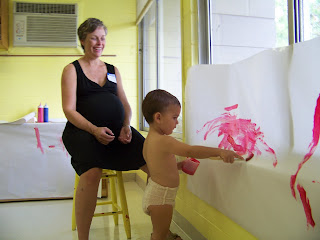 So...What are they really learning?
So...What are they really learning? Not always what you intend...
Throughout the post, I will interject my reflections with "possibilities for learning".
During this week's class, we immersed the children in paint. Painting at the wall, painting on tables, painting on the floor, and painting with toys that roll or walk. This experience gives children the freedom to do what toddlers do best, wander and explore! I want to create a class where parents and children don't have to worry about children "behaving". I hope that when "behaving correctly" leaves the thoughts and minds of the parents and children, that instead, thoughts of investigation, experimentation, curiosity, and inquiry instead emerge. However, that doesn't mean conflict, awkwardness, and tears don't happen. But...I do believe that if we respect children and truly listen to them, they will give us opportunities to model conflict resolution, manners, respect, and responsibility. I admit, I welcome conflict into the classroom because it is only through dialogue and discourse that self-reflection can take place. This may sound like quite a paradox of thoughts but I hope to further clarify.


 Not all children enjoy the process of painting on themselves. Having the animals and trucks available gives them the chance to explore the idea of printmaking without feeling uncomfortable.
Not all children enjoy the process of painting on themselves. Having the animals and trucks available gives them the chance to explore the idea of printmaking without feeling uncomfortable. 









 This was our first experience in class with actual paint brushes. S. showed a strong curiosity for this new implement and really wished to explore it's properties fully. I loved taking the camera on his journey! You can see in his face a real look of intensity as well as... my favorite...wonder and awe!
This was our first experience in class with actual paint brushes. S. showed a strong curiosity for this new implement and really wished to explore it's properties fully. I loved taking the camera on his journey! You can see in his face a real look of intensity as well as... my favorite...wonder and awe! After dipping the brush into the paint, he squishes it in between his fingers. Is he relishing the feel of the bristles or perhaps watching the paint squeeze out between his fingers in the brush?
After dipping the brush into the paint, he squishes it in between his fingers. Is he relishing the feel of the bristles or perhaps watching the paint squeeze out between his fingers in the brush? Here he is also exploring the wooden handle. No part of the brush is uninteresting. It is all important!
Here he is also exploring the wooden handle. No part of the brush is uninteresting. It is all important! S. is curious about the other experiences set up in the room, but is not ready to relinquish his paintbrush. It comes along on his journey.
S. is curious about the other experiences set up in the room, but is not ready to relinquish his paintbrush. It comes along on his journey.


 Mom holds great respect for his endeavors as she dresses in clothes that can get messy and encourages him to hug her and interact with her while he is "messy".
Mom holds great respect for his endeavors as she dresses in clothes that can get messy and encourages him to hug her and interact with her while he is "messy".
 Painting:
Painting:
* Whole arm, large muscle movements strengthen the shoulders/arms of young children. Having lots of opportunity to coordinate and exercise these muscles then makes it possible to have stronger small muscle coordination when they go to write or draw.
* Cause and Effect
* Eye-Hand coordination
* Visual and Spatial awareness are strengthened as children cover part or all of their painting surfaces
* Decision making
* Cooperation and/or problems solving as they share materials
* A sense of identity emerges as children freely create and express themselves






























